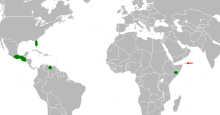Chapmannia
Chapmannia is a genus of legume in the family Fabaceae, and was recently assigned to the informal monophyletic Pterocarpus clade of the Dalbergieae.[1][2]
| Chapmannia | |
|---|---|
| Scientific classification | |
| Kingdom: | |
| (unranked): | |
| (unranked): | |
| (unranked): | |
| Order: | |
| Family: | |
| Subfamily: | |
| Tribe: | |
| Genus: | Chapmannia Torr. & A. Gray |
| Type species | |
| Chapmannia floridana Torr. & A. Gray | |
| Species | |
|
See text. | |
 | |
| Range of the genus Chapmannia. (The red arrow is pointing to the island of Socotra.) | |
| Synonyms[3] | |
| |
Species
Chapmannia comprises the following species:[3][4][5]
- Chapmannia floridana Torr. & A. Gray
- Chapmannia gracilis (Balf. f.) Thulin
- Chapmannia prismatica (Sessé & Moc.) Thulin
- Chapmannia reghidensis Thulin
- Chapmannia sericea Thulin
- Chapmannia somalensis (Hillc. & J.B. Gillett) Thulin
- Chapmannia tinireana Thulin
gollark: > how much is that timeMonths, I think?
gollark: SSDs do apparently lose data if you leave them unplugged for large amounts of time.
gollark: https://en.wikipedia.org/wiki/Flash_memory#Principles_of_operation (apparently it's weird transistors, not capacitors)
gollark: They use flash storage, which... has electrons stored in tiny capacitor things where the charge persists for ages, or something.
gollark: There's a new ATX12VO standard which drops everything but 12V because it's not used much, apparently.
References
- Lavin M, Pennington RT, Klitgaard BB, Sprent JI, de Lima HC, Gasson PE (2001). "The dalbergioid legumes (Fabaceae): delimitation of a pantropical monophyletic clade". Am J Bot. 88 (3): 503–33. doi:10.2307/2657116. JSTOR 2657116. PMID 11250829.
- Cardoso D, Pennington RT, de Queiroz LP, Boatwright JS, Van Wyk BE, Wojciechowskie MF, Lavin M (2013). "Reconstructing the deep-branching relationships of the papilionoid legumes". S Afr J Bot. 89: 58–75. doi:10.1016/j.sajb.2013.05.001.
- Tulhin M. (1999). "Chapmannia (Leguminosae: Stylosanthinae) extended". Nord J Bot. 19 (5): 597–607. doi:10.1111/j.1756-1051.1999.tb01146.x.
- "ILDIS LegumeWeb entry for Chapmannia". International Legume Database & Information Service. Cardiff School of Computer Science & Informatics. Retrieved 10 February 2014.
- USDA; ARS; National Genetic Resources Program. "GRIN species records of Chapmannia". Germplasm Resources Information Network—(GRIN) [Online Database]. National Germplasm Resources Laboratory, Beltsville, Maryland. Archived from the original on 24 September 2015. Retrieved 10 February 2014.
| Wikispecies has information related to Chapmannia |
This article is issued from Wikipedia. The text is licensed under Creative Commons - Attribution - Sharealike. Additional terms may apply for the media files.